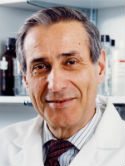Overexpression of basic fibroblast growth factor in MCF-7 human breast cancer cells: Lack of correlation between inhibition of cell growth and MAP kinase activation Journal Article
| Authors: | Wieder, R.; Fenig, E.; Wang, H.; Wang, Q.; Paglin, S.; Menzel, T.; Gabrilove, J.; Fuks, Z.; Yahalom, J. |
| Article Title: | Overexpression of basic fibroblast growth factor in MCF-7 human breast cancer cells: Lack of correlation between inhibition of cell growth and MAP kinase activation |
| Abstract: | Basic fibroblast growth factor (bFGF, FGF-2) is progressively lost from mammary epithelial cells as they become malignant. To investigate the effects of restoring the expression of bFGF in breast cancer cells, we constructed MCF-7 cells that permanently overexpress 18-kD cytoplasm-localizing bFGF (MCF-7/ΔA(FGF(18)) cells) and cells that express both the 18-kD along with the 22- and 24-kD nucleus-localizing bFGF peptides (MCF-7/NCF(FGF(18,22,24) cells)), using retroviral transduction. These stable cell constructs grew more slowly and had a larger fraction of their populations in the G0/G1 phase of the cell cycle than control cells. All forms of bFGF were eluted from MCF-7/NCF(FGF(18,22,24)) cell monolayers with 2 M NaCl, in contrast to fibroblasts that were demonstrated to secrete only the 18-kD bFGF isoform. High-affinity binding of 18-kD 125I-bFGF to these cells was significantly decreased, probably because of competitive binding by the autocrine-secreted bFGF. Recombinant 18-kD bFGF that was previously demonstrated in our laboratory to inhibit proliferation, activate MAP kinase, and induce the cyclin-dependent kinase inhibitor p21(WAF1/CIP1) in MCF-7 cells, further inhibited MCF-7/ΔA(FGF(18)) cells but had no effect on MCF- 7/NCF(FGF(18,22,24)) cells. The total cellular content of the high-affinity FGF receptors 1-3 was unchanged, but FGF receptor 4 was decreased in MCF- 7/NCF(FGF(18,22,24)) cells. Both cell types overexpressing bFGF isoforms had elevated levels of the cyclin-dependent kinase inhibitor p27(Kip1) but not that of p21(WAF1/CIP1). In MCF-7/ΔA(FGF(18)) cells, FGFR1 and MAP kinase were constitutively phosphorylated. Exogenous recombinant 18-kD bFGF did not accentuate these effects but did induce an increase n the levels of p21(WAF1/CIP1) corresponding to the further inhibition induced by exogenous bFGF in these cells. In MCF-7/NCF(FGF(18,22,24)) cells, FGFR1 and MAP kinase were not phosphorylated at baseline nor upon stimulation with recombinant bFGF, and exogenous bFGF only had a minimal effect on low steady-state p21(WAF1/CIP1) levels. However, stimulation of these cells with phorbol ester or insulin did result in MAP kinase phosphorylation. While growth-inhibited in the G1 phase of the cell cycle, MCF-7/NCF(FGF(18,22,24)) cells retained active isoforms of cdk2 and the hyperphosphorylated form of Rb. These data suggest that high molecular weight forms of bFGF overexpressed in MCF-7 cells do not activate the receptor-mediated MAP kinase pathway, and do not induce p21(WAF1/CIP1) in an autocrine manner, but inhibit proliferation through other, possibly direct nuclear signalling mechanisms. |
| Keywords: | mitogen activated protein kinase; controlled study; protein expression; protein phosphorylation; human cell; cell proliferation; proteins; cell cycle; cell division; gene overexpression; breast cancer; cell growth; protein binding; enzyme activation; tumor cells, cultured; breast neoplasms; phosphorylation; transduction, genetic; fibroblast growth factor 2; receptor affinity; cyclins; cell strain mcf 7; g1 phase; phosphotransferases; basic fibroblast growth factor; receptors, fibroblast growth factor; ca(2+)-calmodulin dependent protein kinase; humans; human; priority journal; article; mink cell focus-forming virus |
| Journal Title: | Journal of Cellular Physiology |
| Volume: | 177 |
| Issue: | 3 |
| ISSN: | 0021-9541 |
| Publisher: | John Wiley & Sons, Inc. |
| Date Published: | 1998-12-01 |
| Start Page: | 411 |
| End Page: | 425 |
| Language: | English |
| DOI: | 10.1002/(sici)1097-4652(199812)177:3<411::aid-jcp5>3.0.co;2-y |
| PUBMED: | 9808150 |
| PROVIDER: | scopus |
| DOI/URL: | |
| Notes: | Article -- Export Date: 12 December 2016 -- Source: Scopus |
Altmetric
Citation Impact
BMJ Impact Analytics
Related MSK Work





